Abstract
Kale (Brassica oleracea var. acephala) is known as a vegetable with good tolerance of environmental stress and numerous beneficial properties for human health, which are attributed to different phytochemicals. In the present study, investigation of how low temperatures affect proline, pigments and specialized metabolites content was performed using 8-weeks old kale plants subjected to chilling (at 8 °C, for 24 h) followed by short freezing (at −8 °C, for 1 h after previous acclimation at 8 °C, for 23 h). Plants growing at 21 °C served as a control. In both groups of plants (exposed to low temperatures and exposed to short freezing) a significant increase in proline content (14% and 49%, respectively) was recorded. Low temperatures (8 °C) induced an increase of pigments (total chlorophylls 7%) and phytochemicals (phenolic acids 3%; flavonoids 5%; carotenoids 15%; glucosinolates 21%) content, while exposure to freezing showed a different trend dependent upon observed parameter. After freezing, the content of chlorophylls, carotenoids, and total phenolic acids retained similar levels as in control plants and amounted to 14.65 ± 0.36 mg dw g−1, 2.58 ± 0.05 mg dw g−1 and 13.75 ± 0.07 mg dw CEA g−1, respectively. At the freezing temperature, total polyphenol content increased 13% and total flavonoids and glucosinolates content decreased 21% and 54%, respectively. Our results suggest that acclimatization (23 h at 8 °C) of kale plants can be beneficial for the accumulation of pigments and phytochemicals, while freezing temperatures affect differently specialized metabolite synthesis. The study suggests that growing temperature during kale cultivation must be considered as an important parameter for producers that are orientated towards production of crops with an increasing content of health-related compounds.
1. Introduction
Climate changes that generally cause global warming can cause sudden, low temperature episodes. These types of events can significantly reduce crop production and quality. According to the review article by Ritonga and Chen [1], low temperature is one of the most harmful environmental stresses that higher plants face, along with drought stress. Low temperature stress significantly limits the geographical distribution of plants, but with climate changes and climate disturbances, crops can experience periods of extremely low temperatures uncommon for the region [2]. Crops that experience low-temperature stress suffer impaired growth, which affects and delays essential processes in their development such as flowering, development and fruiting. That may cause loss in crop yields and quality, and in extreme cases, the plant freezes, wilts and dies [2]. Plants differ in their tolerance to chilling (0–15 °C) and freezing (<0 °C) temperatures, and resistance is species- or cultivar-dependent. Chilling tolerant plants often grow in temperate climatic regions, and they can increase their freezing tolerance by being exposed to chilling, non-freezing temperatures, a process known as cold acclimation [3]. Plant tolerance to low temperature may involve mechanisms related to carbohydrates, specialized metabolites and energy metabolism, transcription, signal transduction, protein transport and degradation [3,4,5].
The family Brassicaceae, often called Cruciferae or mustard family, represents a monophyletic group distributed worldwide, except for Antarctica, comprising of approximately 341 genera and 3977 species. The number of genera and species changes frequently in parallel with development of new methods that dissect the genetic diversity of the family in a greater detail [6]. One of the important members is the genus Brassica, which includes significant crop plants such as rapeseed and some commonly used vegetables with a long history of agricultural use around the world [7]. One of the key species is Brassica oleracea that includes vegetables with significant morphological diversity of plant organs and good adaptation to adverse environmental conditions [8]. According to the morphology and other characteristics B. oleracea includes several cultivar groups (Acephala, Botrytis, Capitata group, etc.). Among these groups, plants from Acephala group include leafy, non-heading cabbage varieties with common names of kale and collards. Kale (B.oleracea var. acephala) is known for its good tolerance of environmental stress such as salt, drought and frost hardiness and resistance [8,9,10,11,12,13,14]. Kale is easy and cheap for cultivation and production significantly increased from 3994 to 6256 harvested acres in US, in the time from 2007 to 2012, respectively [15]. In recent years, kale has been marked as a superfood [8] due to its beneficial effects on human health, which are related to the presence of specialized metabolites from the group of polyphenols, carotenoids and glucosinolates, but also important minerals, vitamins and dietary fibres [8,11,13,14]. Kale and collards have higher content of Ca, folate, riboflavin, vitamin C, K and A content than other cruciferous vegetables while their phytochemical content is comparable with other Brassica vegetables [8]. Kale possesses biological activities such as antioxidant and anticarcinogens activity, and protective properties in cases of cardiovascular and gastrointestinal system diseases (reviewed by Šamec et al. [8]). Kale tolerates both high summer temperatures and low winter temperatures, even freezing temperatures for a short period of time. Improved understanding of mechanisms related to kale low temperature tolerance can introduce improved cold resistance varieties, better equipped to deal with unusually low temperatures that might arise during the growth season. Low temperatures during kale cultivation have been reported to affect polyphenolic compounds [16,17], soluble sugars and glucosinolates [18], but most of these studies were conducted in the field where it is difficult to control other environmental parameters.
Tolerance of low temperatures in kale is associated with the content of specialized metabolites that can serve not only as a protective mechanism against environmental stressors for the plant, but also as a source of benefit compounds for human health. We hypothesize that phytochemicals and pigments may play a significant role in kale stress adaptation capability and that short term low temperature exposure affects specialized metabolite content. In the present study, we investigated cold induced changes in specialized metabolite content: polyphenols, glucosinolates and carotenoids, under short term chilling temperatures (8 °C and −8 °C) compared with the control (21 °C). In addition, we determined the effect of short cold stress on basic growth physiological parameters (chlorophyll a, chlorophyll b, total chlorophylls) and stress markers (proline content).
2. Materials and Methods
2.1. Plant Growing and Stress Experiments
Seeds were purchased from the family farm “Srđan Franić”, Vrgorac, Croatia. Seeds were sterilized and germinated as we have previously reported [13]. Approximately 20 seeds per plate were transferred to Petri dishes containing 1% agar (w/v). Plates were first stored in dark at 4 °C for 48 h, then transferred to the growth chamber and maintained at 21 °C for three days with a 16/8 h photoperiod. Seedlings were then placed in pots (diameter 55–73 mm; height 105 mm) containing Stender A240 substrate (Stender GmbH, Schermbeck, Germany) and maintained in a growth chamber at 16/8 h photoperiod (light/dark) at 21 °C. All plants were watered regularly with the same amount of water and transplanted after 4 weeks into larger pots (diameter 130–145 mm; height 110 mm) with fresh substrate to ensure sufficient plant nutrients throughout the experimental period. After 8 weeks of growth, 30 healthy representative plants were selected for cold stress experiments.
The experimental design is shown in Figure 1. Plants from all three groups (control, chilling and freezing group) were harvested at exactly the same time, quickly frozen in liquid nitrogen, and stored at −80 °C followed by freeze-drying (Lyovac GT 2; Steris Deutschland GmbH, Köln, Germany) for further extraction and analysis.
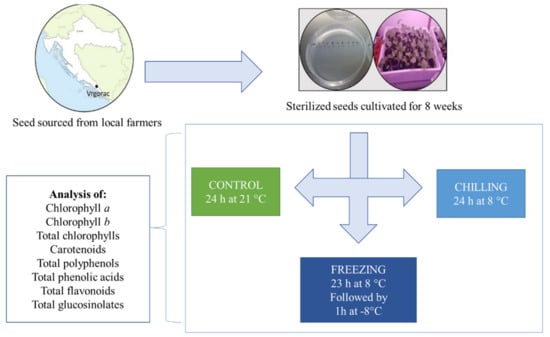
Figure 1.
Schematic diagram of the short-term cold experiments.
2.2. Determination of Proline Content
For proline determination, we extracted 30 mg of freeze-dried tissue with 70% ethanol, as previously reported [10]. For the reaction, a mixture of 100 μL of extract and 1 mL of the reaction mixture (containing 1% ninhydrin, 60% acetic acid, and 20% ethanol) was heated at 95 °C for 20 min, followed by cooling on ice. Absorbance was measured at 520 nm against control using a UV–VIS spectrophotometer (BioSpec-1601, Shimadzu, Kyoto, Japan). Quantification of proline was done according to calibration curve of proline (0–1.6 mM) and expressed as μmol g−1 dw−1.
2.3. Determination of Chlorophylls and Carotenoids Content
To determine concentration of chlorophyll a, chlorophyll b, total chlorophylls, and carotenoids, 10 mg of freeze-dried tissue was extracted using 80% acetone until tissue discoloration. Samples were centrifuged and supernatants were collected for quantification by spectrophotometric absorbance reading at 663.2 nm for chlorophyll a, 646.8 nm for chlorophyll b, and 470 nm for carotenoids [19] and expressed as mg g−1 dw−1.
2.4. Determination of Polyphenolic Compounds
For the determination of the content of polyphenolic compounds, extracts were prepared by mixing 60 mg of dried material with 2 mL of 80% methanol and the extraction was performed as previously reported [14].
For the determination of total polyphenols, total phenolic acids and total flavonoids, we used well-established methods suitable for small-scale volumes and for Brassicacea plants [20]. For the determination of total phenols content, Folin–Ciocâlteu method was used and the calibration curve was constructed using gallic acid as the standard. Results are expressed as milligrams of gallic acid equivalents per gram of dry weight (mg GAE g−1dw−1). For the determination of phenolic acids, a mixture of sodium nitrite and sodium molybdate was used and caffeic acid was used to construct the calibration curve. Results are expressed as caffeic acid equivalents per gram of dry weight (mg CAE g−1dw−1). Flavonoids were determined using Al2O3 method, catechin was used as the standard to construct the calibration curve, and results are expresses as catechin equivalents per gram of dry weight (mg CE g−1 dw−1).
2.5. Determination of Total Glucosinolates
For the determination of total glucosinolates, an established method based on the reaction with sodium tetrachloropalladate II (Na2PdCl4) [21] was adapted as previously reported [14]. Sinigrin standard was used to construct the calibration curve and the results are expressed as sinigrin equivalents per gram of dry weight (mg g−1 dw−1).
2.6. Statistical Analysis
All analyses were performed in at least three replicates and results are expressed as mean ± standard deviation (SD). All statistical analyses were performed using the free software PAST [22]. One-way ANOVA and post hoc multiple mean comparison (Tukey’s HSD test) were performed and differences between measurements were considered significant at p < 0.05.
3. Results
3.1. Effect of Cold Stress on Proline Content in Kale
Increase in proline content was noticed after exposure to cold stress was strongly related to the drop of the temperature (Figure 2). After 24 h at chilling temperatures (8 °C), proline content was 14% higher than in the control plants, with additional increase to 49% in kale exposed to −8 °C for 1 h after 23 h of acclimation. The rise of proline, as one of cold stress markers, is a clear indication that kale plants perceive the administered temperatures as cold stress.
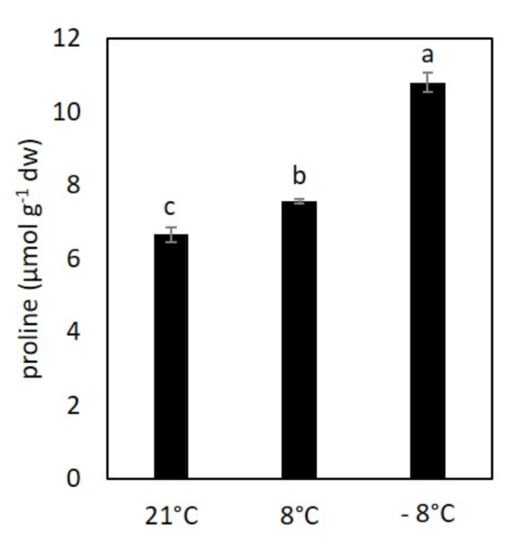
Figure 2.
The proline content in kale plants exposed to cold stress. Value marked with different letters are significantly different at p < 0.05.
3.2. Effect of Cold Stress on Content of Chlorophylls and Carotenoids in Kale
Concentration of chlorophylls in chilled plants showed a significant increase in content of chlorophyll a, b and total chlorophylls (Figure 3), indicating that cold stressed plants increased the rate of synthesis of chlorophylls. In case of previous acclimatization of plants to chilling temperatures followed by exposure for freezing temperatures, the plant’s photosynthetic apparatus was less affected and the content of photosynthetic pigments remained similar to the levels recorded for stress free control plants.

Figure 3.
The content of chlorophyl a (a), chlorophyl b (b) and total chlorophylls (c) in kale exposed to low temperatures. Value marked with different letters are significantly different at p < 0.05.
The content of carotenoids in kale under low temperatures is shown in Figure 4. In the control, the content of carotenoids was 2.71 ± 0.06 mg g−1 and their amount followed the same trend as that of chlorophylls—under 8 °C increase, but their content in plants subjected to freezing temperature was comparable with those in the control plants.
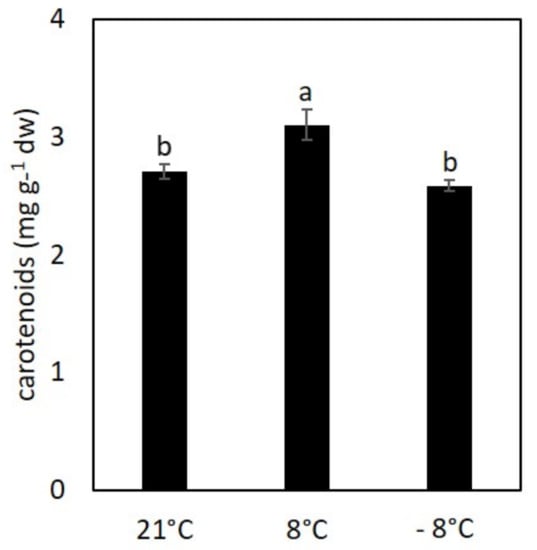
Figure 4.
The content of carotenoids in kale exposed to low temperatures. Value marked with different letters are significantly different at p < 0.05.
The ratio of chlorophyll a and chlorophyll b, as well as the ratio of total chlorophylls and total carotenoids could provide useful information about adaptation of plants to stress conditions [19]. Our values for those parameters are shown at Table 1. The ratio of chlorophyll a/chlorophyll b remained stable for under chilling temperatures while significant increase was recorded for plants exposed to freezing temperature. The ratio of total chlorophylls/total carotenoids remained stable under cold stress.

Table 1.
The ratio of chlorophyll a/chlorophyll b and total chlorophylls/total carotenoids in kale exposed to low temperatures. Value marked with different letters are significantly different at p < 0.05.
3.3. Effect of Cold Stress on Content of Polyphenolic Compounds in Kale
Significant changes in polyphenolic compounds was recorded in plants exposed to freezing temperatures and results are shown at Figure 5. For total phenolic acids, the trend was different and only plants at chilling temperature showed significantly higher content than in the control. For flavonoids, a slight increase was observed at chilling temperature, while total flavonoid content decreased at freezing temperature compared with the control and plants at chilling temperature, suggesting that polyphenolic compounds are main metabolites synthesized during acclimation and counteracting cold stress induced by freezing temperatures.
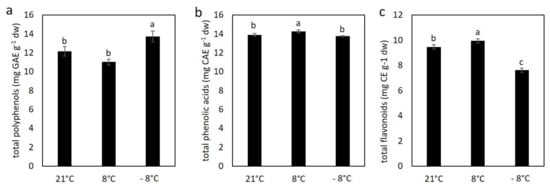
Figure 5.
The content of total polyphenols (a), total phenolic acids (b) and total flavonoids (c) in kale exposed to low temperatures. Value marked with different letters are significantly different at p < 0.05.
3.4. Content of Glucosinolates under Low Temperature
The level of glucosinolates was majorly affected by cold stress as is shown at Figure 6. Exposure to chilling temperatures induced an increase in glucosinolates synthesis while a significant drop in glucosinolates content in plants exposed to freezing temperatures was recorded.
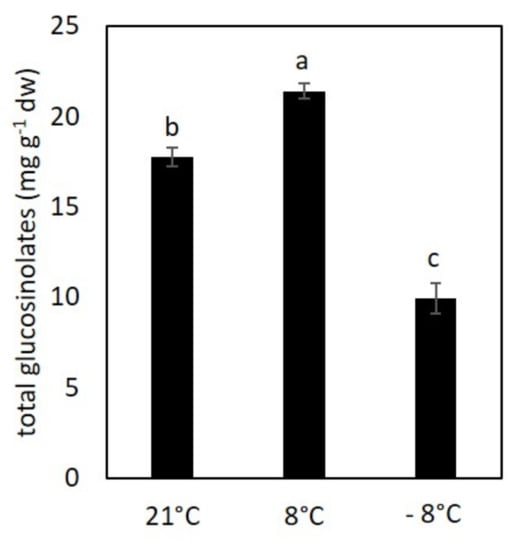
Figure 6.
The content of total glucosinolates in kale exposed to low temperatures. Value marked with different letters are significantly different at p < 0.05.
4. Discussion
Proline is an amino acid that plays an important role in plant metabolism and development. Its accumulation is associated with plant stress response where it acts as an osmolyte, metal chelator, antioxidant defence molecule and signalling molecule (reviewed by Hayat et al. [23]. In the presented study, proline also acted as a protective molecule against cold stress with recorded increase in content correlating to the temperature drop (Figure 2). Similar results were reported for frost-resistant mutants of cauliflower (Brassica oleracea var. botrytis) by Hady et al. [24] and Fuller et al. [25] Proline accumulation is reported to be associated with cold stress tolerance in many other crops such as beans [26], sorghum [27], and rice as well [28]. Stressful environment cause changes in a variety of physiological, biochemical, and molecular processes in plants, which is evident from the proline levels mentioned above, but it can also affect photosynthesis, the most fundamental and complicated physiological process in all green plants [29]. Photosynthesis is an essential process for plants, and it is very sensitive to changes in environmental conditions [30]. Chlorophylls play important role in photosynthesis in harvesting and converting light energy in the antenna systems and charge separation and electron transport in the reaction centres [31]. Therefore, chlorophyll content is an important parameter to evaluate photosynthetic capacity. The level of chlorophyll a, b, and total chlorophylls and carotenoids was decreased after exposure to chilling temperature, while staying stable under freezing temperature in similar concentration as in control plants. Freezing temperatures normally cause a decrease in the ratio of total chlorophyll to carotenoids [12], but the acclimatization period in chilling period was much longer, so decrease in chlorophylls can also be a response to long exposure to chilling rather than freezing itself.
The ratio of total chlorophylls and carotenoids is an indicator of the plant greenness [19] and in our experiment chilling temperatures did not change significantly the ratio. The ratio of chlorophyll a/chlorophyll b may be an indicator of the functional pigment endowment and light adaptation of the photosynthetic apparatus [19]. Under stress conditions in plants, both chlorophyll a and chlorophyll b tend to decrease while, the chlorophyll a/b ratio tends to increase due to greater reduction in chlorophyll b compared to chlorophyll a [29]. Accordingly, our results indicate notable stress under freezing temperatures.
Kale is also considered a good source of carotenoids [32]. Carotenoids are essential pigments in photosynthetic organs along with chlorophylls where they act as photoprotectors, antioxidants, colour attractants, and precursors of plant hormones in non-photosynthetic organs of plants [33]. In addition, they play important roles in humans such as precursors of vitamin A, photoprotectants, antioxidants, enhancers of immunity, and others [33]. Under our experimental conditions, in control plants, total carotenoid content was 2.71 ± 0.06 µg g−1, increased to 3.10 ± 0.13 µg g−1 under 8 °C and decreased to 2.58 ± 0.05 µg g−1 under −8 °C. Similarly, Hwang et al. [34] reported a gradual increase in total carotenoid content of kale during cold acclimatizationon for 3 days. They noted an increase in zeaxanthin content under cold stress. Mageney et al. [32] also reported high zeaxanthin contents in kale under traditional harvest conditions consistent with low temperatures. Consistent with reported papers, our results show that cold acclimatization may be beneficial for carotenoid content accumulation. According to our previously published work comparing the carotenoid content in kale with that of white cabbage and Chinese cabbage, kale tends to accumulate a higher amount of carotenoids, which may be related to its better tolerance to low temperatures [10,11].
Polyphenol compounds are considered an important player in the response of plants to abiotic stress, including low temperature stress [35]. The content of total polyphenols, phenolic acids and flavonoids in our experiments is shown in Figure 6. Polyphenol content differed between chilling and freezing where decrease and significant increase was recorded, respectively. Jurkow et al. [36] also reported increased levels of polyphenols in kale after moderate (−5 °C) and severe (−15 °C) frost compared to the pre-freezing (>0 °C) period. Similarly, Lee and Oh [16] reported increased levels of polyphenolic compounds in 3 weeks old kale exposed to 4 °C for 3 days. They also reported an increase in the content of phenolic acids, caffeic acid and ferulic acid, and flavonoid kaempferol after low temperature treatment at 4 °C. The same authors in another study [17] observed no differences in total flavonoid content in kale grown at 10 °C compared to the control. Our results for total flavonoids content are consistent with these findings; we found no significant changes in total flavonoids and phenolic acids at 8 °C, but a decrease in flavonoids at freezing (−8 °C) temperature was observed. The duration of exposure to low temperature and prior acclimatization may have an influence on the level of phenolic compounds under low temperature stress [18], and probably this is the reason for different trends published in different papers. In addition, individual phenolic compounds, or their conformation (e.g., conjugates, etc.) may change at low temperatures, which cannot always be observed by measuring total phenolic compounds content [37]. Low temperatures induce changes in cellular ultrastructure and localization of phenolic compounds, as has been reported for rapeseed (B. napus var. oleifera) leaves [38] and this may also affect polyphenolic compounds extraction and their detection.
Glucosinolates are well-known specialized metabolites characteristic for Brassicacea plants. Their contents in plants exposed to low temperatures compared to the control in our experiments are shown in Figure 6, where we observed an interesting trend. Under chilling temperature their content increased, while under additional freezing temperature their content decreased significantly. This trend is different from the one we reported previously, where the content of glucosinolates increases under chilling and freezing temperatures [12]. This different trend may be due to different experimental conditions and age of plants as reported in our previous work [12], where we exposed plants to freezing temperature for 1 h after 1 week of acclimation. Differences in glucosinolates trend reported in different papers are probably due to different experimental conditions, e.g., temperatures, duration of acclimation, etc., which may influence accumulation of different phytochemicals or be related to the kale variety.
5. Conclusions
In a present study, 8 weeks old kale plants were exposed to short-term low temperature stress (chilling and freezing) to study changes in proline, phytochemicals and pigments content under low temperature. Increases in proline content indicate that stress protective mechanisms were activated in plants at low temperatures and confirmed proline as a reliable stress marker for low temperature stress. Compared to the control, plants exposed to 8 °C (chilling temperatures) for 24 h accumulated significantly higher content of chlorophyll a, b, total chlorophylls, and carotenoid as well as content of total polyphenols, flavonoids and glucosinolates. This may indicate that short term (24 h) chilling temperature is beneficial for the accumulation of phytochemicals in kale. However, our results also suggest that freezing temperatures (−8 °C) may cause significant stress and decrease in pigments and phytochemical levels. Changes in measured phytochemicals indicate that they play significant role in chilling and freezing tolerance in used kale variant, but future more advanced metabolomics and transcriptomic studies will explain the mechanisms in more detail.
Author Contributions
Conceptualization, D.Š.; methodology, D.Š.; formal analysis, D.Š.; V.L.; investigation, V.L., D.Š., B.S.-S.; writing—original draft preparation, D.Š.; writing—review and editing, D.Š.; B.S.-S., B.S.-S., E.K.; visualization, D.Š.; supervision, D.Š.; project administration, D.Š.; B.S.-S.; funding acquisition, D.Š.; B.S.-S. All authors have read and agreed to the published version of the manuscript.
Funding
This research was funded by Unity through Knowledge Fund, grant number 12/17, and by the Operational Programme Competitiveness and Cohesion 2014–2020 and the Croatian European regional fund under a specific scheme to strengthen applied research in proposing actions for climate change adaptation (Project No. KK.05.1.1.02.0005).
Institutional Review Board Statement
Not Applicable.
Informed Consent Statement
Not Applicable.
Data Availability Statement
Additional data are available upon request.
Acknowledgments
We thank Srđan Franić for providing the seeds used in the experiment.
Conflicts of Interest
The authors declare no conflict of interest.
References
- Ritonga, F.N.; Chen, S. Physiological and Molecular Mechanism Involved in Cold Stress Tolerance in Plants. Plants 2020, 9, 560. [Google Scholar] [CrossRef]
- Hussain, H.A.; Hussain, S.; Khaliq, A.; Ashraf, U.; Anjum, S.A.; Men, S.; Wang, L. Chilling and Drought Stresses in Crop Plants: Implications, Cross Talk, and Potential Management Opportunities. Front. Plant Sci. 2018, 9, 393. [Google Scholar] [CrossRef]
- Sanghera, G.S.; Wani, S.H.; Hussain, W.; Singh, N.B. Engineering Cold Stress Tolerance in Crop Plants. Curr. Genom. 2011, 12, 30–43. [Google Scholar] [CrossRef] [Green Version]
- Carvajal, F.; Rosales, R.; Palma, F.; Manzano, S.; Cañizares, J.; Jamilena, M.; Garrido, D. Transcriptomic changes in Cucurbita pepo fruit after cold storage: Differential response between two cultivars contrasting in chilling sensitivity. BMC Genom. 2018, 19, 125. [Google Scholar] [CrossRef] [PubMed] [Green Version]
- Yang, L.; Wen, K.-S.; Ruan, X.; Zhao, Y.-X.; Wei, F.; Wang, Q. Response of Plant Secondary Metabolites to Environmental Factors. Molecules 2018, 23, 762. [Google Scholar] [CrossRef] [PubMed] [Green Version]
- Franzke, A.; Lysak, M.A.; Al-Shehbaz, I.A.; Koch, M.A.; Mummenhoff, K. Cabbage family affairs: The evolutionary history of Brassicaceae. Trend. Plant Sci. 2011, 16, 108–116. [Google Scholar] [CrossRef]
- Šamec, D.; Salopek-Sondi, B. Cruciferous (Brassicaceae) vegetables. In Nonvitamin and Nonmineral Nutritional Supplements; Nabavi, S.M., Sanches Silva, T., Eds.; Academic Press: Cambridge, MA, USA, 2019; pp. 195–202. [Google Scholar]
- Šamec, D.; Urlić, B.; Salopek-Sondi, B. Kale (Brassica oleracea var. acephala) as a superfood: Review of the scientific evidence behind the statement. Crit. Rev. Food Sci. Nutr. 2019, 59, 2411–2422. [Google Scholar] [CrossRef] [PubMed]
- Pavlović, I.; Petrík, I.; Tarkowska, D.; Lepeduš, H.; Vujčić Bok, V.; Radić Brkanac, S.; Novák, O.; Salopek Sondi, B. Correlations between Phytohormones and Drought Tolerance in Selected Brassica Crops: Chinese Cabbage, White Cabbage and Kale. Int. J. Mol. Sci. 2018, 19, 2866. [Google Scholar] [CrossRef] [Green Version]
- Linić, I.; Šamec, D.; Grúz, J.; Vujčić Bok, V.; Strnad, M.; Salopek Sondi, B. Involvement of Phenolic Acids in Short-Term Adaptation to Salinity Stress is Species-Specific among Brassicaceae. Plants 2019, 8, 155. [Google Scholar] [CrossRef] [Green Version]
- Šamec, D.; Linić, I.; Salopek-Sondi, B. Salinity Stress as an Elicitor for Phytochemicals and Minerals Accumulation in Selected Leafy Vegetables of Brassicaceae. Agronomy 2021, 11, 361. [Google Scholar] [CrossRef]
- Ljubej, V.; Radojčić Redovniković, I.; Salopek-Sondi, B.; Smolko, A.; Roje, S.; Šamec, D. Chilling and Freezing Temperature Stress Differently Influence Glucosinolates Content in Brassica oleracea var. acephala. Plants 2021, 10, 1305. [Google Scholar] [CrossRef]
- Šamec, D.; Pavlović, I.; Radojčić Redovniković, I.; Salopek-Sondi, B. Comparative analysis of phytochemicals and activity of endogenous enzymes associated with their stability, bioavailability and food quality in five Brassicaceae sprouts. Food Chem. 2018, 269, 96–102. [Google Scholar] [CrossRef]
- Šamec, D.; Kruk, V.; Ivanišević, P. Influence of Seed Origin on Morphological Characteristics and Phytochemicals Levels in Brassica oleracea var. acephala. Agronomy 2019, 9, 502. [Google Scholar] [CrossRef] [Green Version]
- USDA, National Agricultural Statistics Service. 2012; Census of Agriculture. Available online: https://www.agcensus.usda.gov/Publications/2012/Full_Report/Volume_1,_Chapter_1_US/st99_1_038_038.pdf (accessed on 18 September 2021).
- Lee, J.-H.; Oh, M.-M. Short-term Low Temperature Increases Phenolic Antioxidant Levels in Kale. Hortic. Environ. Biotechnol. 2015, 56, 588–596. [Google Scholar] [CrossRef]
- Lee, J.-H.; Kwon, M.C.; Jung, E.S.; Lee, C.H.; Oh, M.-M. Physiological and Metabolomic Responses of Kale to Combined Chilling and UV-A Treatment. Int. J. Mol. Sci. 2019, 20, 4950. [Google Scholar] [CrossRef] [PubMed] [Green Version]
- Steindal, A.L.H.; Rødven, R.; Hansen, E.; Mølmann, J. Effects of photoperiod, growth temperature and cold acclimatisation on glucosinolates, sugars and fatty acids in kale. Food Chem. 2015, 174, 44–51. [Google Scholar] [CrossRef] [PubMed]
- Lichtenthaler, H.K.; Buschmann, C. Chlorophylls and carotenoids: Measurement and characterization by UV–VIS spectroscopy. In Current Protocols in Food Analytical Chemistry; John Wiley & Sons, Inc.: Hoboken, NJ, USA, 2001; pp. F4.3.1–F4.3.8. [Google Scholar]
- Šamec, D.; Bogović, M.; Vincek, D.; Martinčić, J.; Salopek-Sondi, B. Assessing the authenticity of the white cabbage (Brassica oleracea var. capitata f. alba) cv. ‘Varaždinski’ by molecular and phytochemical markers. Food Res. Int. 2014, 60, 266–272. [Google Scholar] [CrossRef]
- Aghajanzadeh, T.; Hawkesford, M.J.; Kok, L.J. The significance of glucosinolates for sulfur storage in Brassicaceae seedlings. Front. Plant Sci. 2014, 5, 704. [Google Scholar] [CrossRef] [PubMed] [Green Version]
- Hammer, O.; Harper, A.A.T.; David, A.T.; Ryan, P.D. PAST: Paleontological Statistics Software Package for Education and Data Analysis. Palaeontol. Electron 2001, 4, 1–9. [Google Scholar]
- Hayat, S.; Hayat, Q.; Alyemeni, M.N.; Wani, A.S.; Pichtel, J.; Ahmad, A. Role of proline under changing environments. Plant Signal. Behav. 2012, 7, 1456–1466. [Google Scholar] [CrossRef] [Green Version]
- Hadi, F.; Gilpin, M.; Fuller, M.P. Identification and expression analysis of CBF/DREB1 and COR15 genes in mutants of Brassica oleracea var. botrytis with enhanced proline production and frost resistance. Plant Physiol. Biochem. 2011, 49, 1323–1332. [Google Scholar] [CrossRef] [PubMed] [Green Version]
- Fuller, M.P.; Metwali, E.M.R.; Eed, M.H.; Jellings, A.J. Evaluation of Abiotic Stress Resistance in Mutated Populations of Cauliflower (Brassica oleracea var. botrytis). Plant Cell Tissue Organ. Cult. 2006, 86, 239. [Google Scholar] [CrossRef]
- Neto, N.B.M.; Custódio, C.C.; Gatti, A.B.; Priolli, M.R.; Cardoso, V.J.M. Proline: Use as an indicator of temperature stress in bean seeds. Crop Breed. Appl. Biotechnol. 2004, 4, 330–337. [Google Scholar] [CrossRef]
- Vera-Hernández, P.; Ramírez, M.A.O.; Núñez, M.M.; Ruiz-Rivas, M.; Rosas-Cárdenas, F.F. Proline as a probable biomarker of cold stress tolerance in Sorghum (Sorghum bicolor). Mex. J. Biotechnol. 2018, 3, 77–86. [Google Scholar] [CrossRef]
- de Freitas, G.M.; Thomas, J.; Liyanage, R.; Lay, J.O.; Basu, S.; Ramegowda, V.; do Amaral, M.N.; Benitez, L.C.; Braga, E.J.B.; Pereira, A. Cold tolerance response mechanisms revealed through comparative analysis of gene and protein expression in multiple rice genotypes. PLoS ONE 2019, 14, e0218019. [Google Scholar] [CrossRef]
- Ashraf, M.; Harris, P.J.C. Photosynthesis under stressful environments: An overview. Photosynthetica 2013, 51, 163–190. [Google Scholar] [CrossRef]
- Ensminger, I.; Busch, F.; Huner, N.P.A. Photostasis and cold acclimation: Sensing low temperature through photosynthesis. Phisiol. Plant. 2006, 126, 28–44. [Google Scholar] [CrossRef]
- Zhao, Y.; Han, Q.; Ding, C.; Huang, Y.; Liao, J.; Tao Chen, T.; Feng, S.; Zhou, L.; Zhang, Z.; Chen, Y.; et al. Effect of Low Temperature on Chlorophyll Biosynthesis and Chloroplast Biogenesis of Rice Seedlings during Greening. Int. J. Mol. Sci. 2020, 21, 1390. [Google Scholar] [CrossRef] [Green Version]
- Mageney, V.; Baldermann, S.; Albach, D.C. Intraspecific Variation in Carotenoids of Brassica oleracea var. sabellica. J. Agric. Food Chem. 2016, 64, 3251–3257. [Google Scholar] [CrossRef] [PubMed]
- Maoka, T. Carotenoids as natural functional pigments. J. Nat. Med. 2020, 74, 1–16. [Google Scholar] [CrossRef] [PubMed] [Green Version]
- Hwang, S.-J.; Chun, J.-H.; Kim, S.-J. Effect of Cold Stress on Carotenoids in Kale Leaves (Brassica oleracea). Korean J. Environ. Agric. 2017, 36, 106–112. [Google Scholar] [CrossRef] [Green Version]
- Šamec, D.; Karalija, E.; Šola, I.; Vujčić-Bok, V.; Salopek-Sondi, B. The Role of Polyphenols in Abiotic Stress Response: The Influence of Molecular Structure. Plants 2021, 10, 118. [Google Scholar] [CrossRef] [PubMed]
- Jurkow, R.; Wurst, A.; Kalisz, A.; Sękara, A.; Cebula, S. Cold stress modifies bioactive compounds of kale cultivars during fall–winter harvests. Acta Agrobot. 2019, 72, 1761. [Google Scholar] [CrossRef] [Green Version]
- Schmidt, S.; Zietz, M.; Schreiner, M.; Rohn, S.; Kroh, L.W.; Krumbein, A. Genotypic and climatic influences on the concentration and composition of flavonoids in kale (Brassica oleracea var. sabellica). Food. Chem. 2010, 119, 1293–1299. [Google Scholar] [CrossRef]
- Stefanowska, M.; Kuras, M.; Kacperska, A. Low Temperature-induced Modifications in Cell Ultrastructure and Localization of Phenolics in Winter Oilseed Rape (Brassica napus L. var. oleifera L.) Leaves. Ann Bot. 2002, 90, 637–645. [Google Scholar] [CrossRef] [Green Version]
Publisher’s Note: MDPI stays neutral with regard to jurisdictional claims in published maps and institutional affiliations. |
© 2021 by the authors. Licensee MDPI, Basel, Switzerland. This article is an open access article distributed under the terms and conditions of the Creative Commons Attribution (CC BY) license (https://creativecommons.org/licenses/by/4.0/).